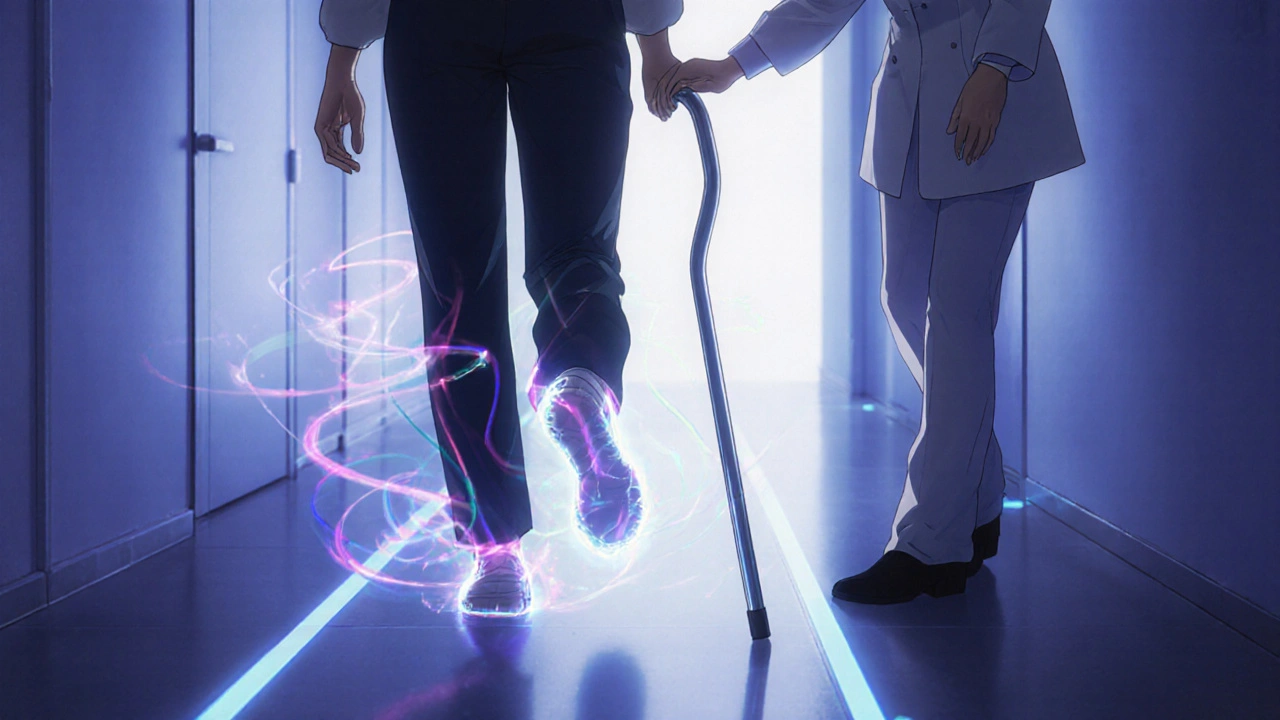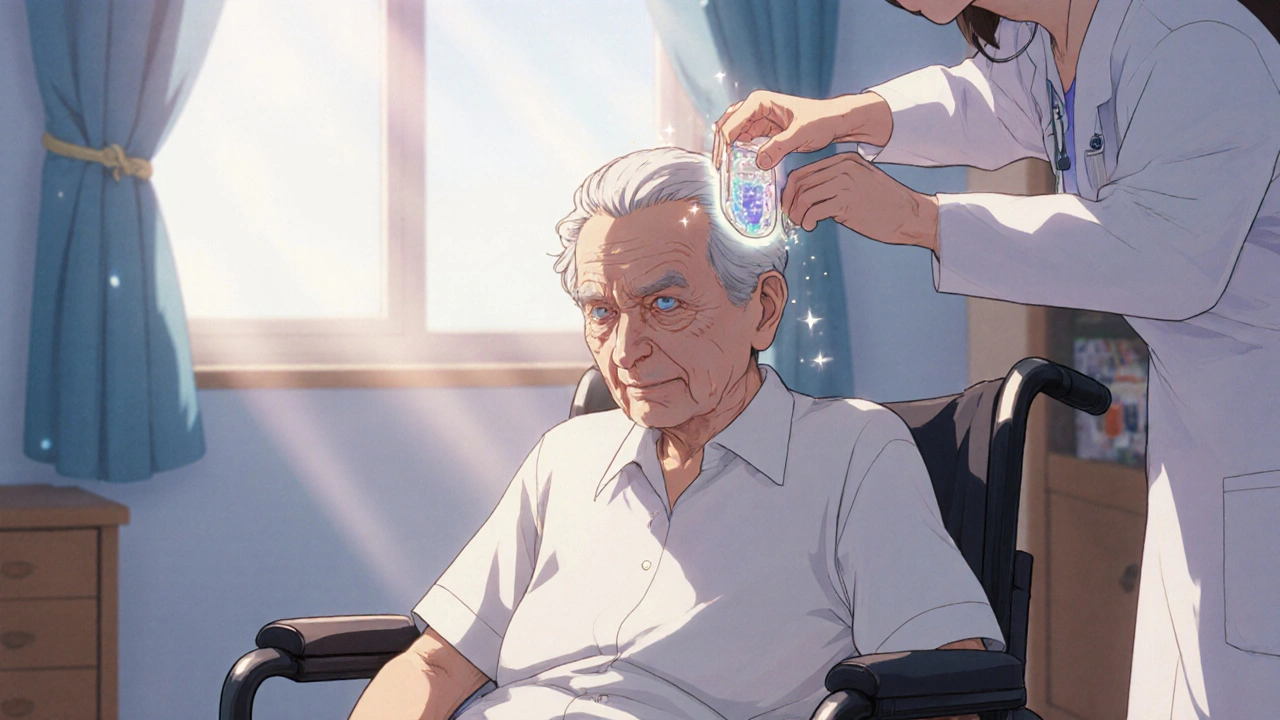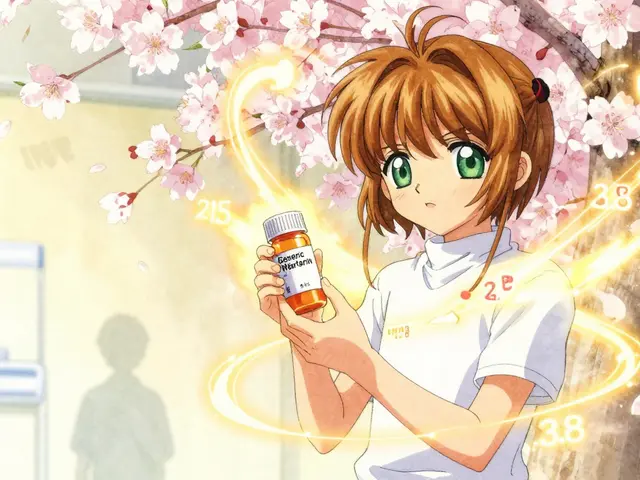Parkinsonism Stage Explorer
Understand Parkinsonism Progression
This tool helps you understand what to expect at each stage of Parkinsonism progression. Use it to review typical symptoms, treatment options, and care considerations for each stage. Note: This tool is for educational purposes only and does not replace professional medical advice.
Select a Stage
Progression Timeline
Select a stage to view information
Click on any stage to see symptoms, treatment options, and care considerations
When you first hear the word Parkinsonism is a neurological syndrome characterized by tremor, rigidity, bradykinesia, and postural instability. It can stem from Parkinson's disease or a range of other disorders that affect the same brain pathways. If you or a loved one has been diagnosed, the inevitable question is: "What comes next?" This guide walks you through the typical stages, what symptoms to expect, and how treatment strategies evolve.
Why Staging Matters
Understanding the progression helps patients set realistic goals, plan caregiving, and choose therapies at the right time. Doctors often use two main tools: the Hoehn and Yahr scale and the Unified Parkinson's Disease Rating Scale (UPDRS). Both translate a complex mix of motor and non‑motor signs into numbers you can track.
Stage 1: Early Signs and Subtle Changes
At this point, symptoms are usually mild and may affect only one side of the body. Common clues include:
- Fine tremor in a hand or foot, often noticeable when the limb is at rest.
- Very slight stiffness that feels like a pulled muscle after waking.
- Reduced facial expression (mask-like face), which friends might attribute to fatigue.
- Occasional difficulty finding words, though cognition remains intact.
Many patients can continue working and driving without adjustments. Levodopa, the gold‑standard medication that boosts dopamine, is typically withheld until motor symptoms interfere with daily activities.
Stage 2: Bilateral Involvement but Still Independent
Symptoms now appear on both sides of the body, though balance remains relatively stable. Expect:
- Stiffness in the neck, shoulders, and torso that makes turning the head slower.
- Frequent shuffling gait; a person may need to take smaller steps to avoid tripping.
- Micrographia - handwriting that becomes increasingly cramped.
- Non‑motor issues such as constipation, loss of sense of smell, or mild sleep disturbances.
Physiotherapy becomes a key part of the regimen. Doctors may start a low dose of Levodopa or dopamine agonists like pramipexole to smooth out the tremor.
Stage 3: Postural Instability Sets In
This is the first stage where balance problems become noticeable. Falls may happen, especially when turning quickly or walking in the dark. Typical features include:
- Frequent stumbling or freezing of gait - a sudden inability to move forward.
- Rapid eye movement (REM) sleep behavior disorder, where vivid dreams cause physical activity.
- Increased rigidity that makes dressing or brushing teeth a chore.
- More pronounced non‑motor symptoms like anxiety or mild depression.
At this point, many neurologists recommend a comprehensive medication review. Adjusting the timing of Levodopa doses can reduce “off” periods when symptoms flare.

Stage 4: Severe Disability, Still Able to Walk with Assistance
Patients typically need a cane, walker, or a wheelchair for longer distances. Daily life looks different:
- Daily dressing, bathing, and meal preparation may require help.
- Speech becomes softer and may be slurred; a speech‑language pathologist can aid communication.
- Non‑motor complications such as hallucinations, especially if on high‑dose dopamine medications.
- Autonomic dysfunction-blood pressure drops when standing, sweating abnormalities, urinary urgency.
When medication alone no longer provides smooth control, many turn to advanced therapies. Deep Brain Stimulation (DBS) involves implanting electrodes in specific brain regions (usually the subthalamic nucleus) to modulate abnormal electrical activity. Clinical studies show DBS can reduce medication doses by up to 50 % and improve motor scores markedly.
Stage 5: Advanced Parkinsonism, Wheelchair‑Bound
In the final stage, patients often spend most of their time seated or lying down. Core challenges are:
- Severe rigidity and bradykinesia that limit even minimal movements.
- Profound dysphagia, increasing risk of aspiration pneumonia.
- Cognitive decline-up to 60 % develop dementia resembling Lewy body disease.
- Frequent infections, pressure ulcers, and other complications that require professional caregiving.
Palliative care becomes the focus, emphasizing comfort, pain management, and quality of life. Medications are tapered to avoid side effects, and caregivers receive training on feeding tubes, mobility aids, and emergency protocols.
How the Brain Changes: Lewy Bodies and Dopamine Loss
The hallmark of Parkinsonism is the accumulation of Lewy bodies-abnormal protein clumps containing alpha‑synuclein. Over time, these deposits disrupt the substantia nigra, the brain region that manufactures dopamine. The resulting deficiency explains the classic tremor‑rigidity‑bradykinesia triad. Understanding this pathology helps explain why dopamine‑boosting drugs are effective early on but lose potency as neuronal loss continues.

Quick Reference: Hoehn & Yahr vs. UPDRS
| Aspect | Hoehn & Yahr | UPDRS (Motor Section) |
|---|---|---|
| Scope | Global stage (1‑5) | Detailed score (0‑108) |
| Focus | Mobility & balance | Individual motor tasks (tremor, rigidity, gait, speech) |
| Clinical use | Quick bedside assessment | Research & longitudinal tracking |
| Typical score range per stage | Stage 1 ≈ 0‑20, Stage 5 ≈ 80‑108 | Varies widely; higher scores mean more severe impairment |
Both tools are complementary. Use Hoehn & Yahr for a snapshot, and UPDRS when you need granular data to adjust therapy.
Living with Parkinsonism: Practical Tips by Stage
- Stage 1‑2: Adopt a regular exercise routine (tai chi, swimming). Track medication timing with a phone app.
- Stage 3: Install grab bars in the bathroom, wear slip‑resistant shoes, and practice fall‑prevention drills with a therapist.
- Stage 4: Explore assistive devices (weighted utensils, voice‑activated smart home tech). Discuss DBS eligibility with a movement‑disorder specialist.
- Stage 5: Coordinate with a home‑health nurse, arrange respite care, and consider hospice services if quality of life declines.
Nutrition matters at every step. High‑fiber diets help with constipation, while adequate protein spreads across the day to avoid competition with Levodopa absorption.
Common Myths Debunked
- Myth: Parkinsonism only affects older men.
Fact: Women and people in their 40s can develop the syndrome, though incidence rises after age 60. - Myth: Medication cures the disease.
Fact: Drugs manage symptoms but do not halt neurodegeneration. - Myth: All tremors mean Parkinson’s.
Fact: Essential tremor and drug‑induced tremor are separate conditions.
Future Directions: Research on Disease‑Modifying Therapies
Scientists are exploring gene therapy to deliver enzymes that boost dopamine production, as well as antibodies targeting alpha‑synuclein aggregates. Early‑phase trials show promise, but wide adoption likely lies beyond the next five years.
How fast does Parkinsonism progress?
Progression varies widely. Some people stay in Stage 2 for a decade, while others move from Stage 1 to Stage 4 in five years. Factors include age at onset, genetics, and how aggressively symptoms are managed.
Can lifestyle changes slow the disease?
Regular aerobic exercise, balanced nutrition, and stress‑reduction techniques have been linked to slower motor decline in several longitudinal studies.
When should I consider Deep Brain Stimulation?
DBS is usually offered after medication fluctuations become disabling (often around Stage 3‑4) and when the patient can tolerate surgery. A multidisciplinary evaluation is essential.
What are the biggest non‑motor symptoms to watch for?
Sleep disturbances, constipation, mood changes, and cognitive decline often appear before motor issues become severe. Early detection helps tailor treatment.
Is there a cure for Parkinsonism?
Currently, no cure exists. Therapies aim to control symptoms and maintain quality of life. Ongoing research into disease‑modifying drugs holds future hope.








Taylor Haven October 22, 2025
The truth about Parkinsonism is being hidden behind a veil of pharmaceutical profit, and it’s high time we pull that veil down.
Big pharma has turned the disease into a cash‑cow, selling drugs that mask symptoms while the underlying neurodegeneration keeps marching on.
Every new “breakthrough” is just a repackaged formulation designed to keep patients buying forever.
They flood the market with levodopa variants, promising miracles, yet they never address the root cause – the dying dopamine neurons.
Imagine a world where research was funded by unbiased public grants instead of stock‑market pressures; we might finally see disease‑modifying therapies rather than endless symptom control.
Meanwhile, the medical establishment shushes dissenting voices, labeling them as “conspiracy theorists” while they whisper about the same hidden agenda in conference corridors.
The staging scales themselves were built to create a sense of inevitability, making patients accept a linear decline as the only option.
But the reality is that lifestyle, exercise, and early intervention can dramatically alter the trajectory, a fact that gets buried under glossy ads.
When you read about deep‑brain stimulation, remember it’s a lucrative surgery that companies market aggressively, often to patients who could benefit more from a disciplined rehab program.
And the non‑motor symptoms – constipation, sleep problems, depression – are brushed aside as “minor” when they are the real quality‑of‑life killers.
Why do we accept that? Because the system rewards conformity, not critical inquiry.
Every “expert” who repeats the same textbook line is being paid, directly or indirectly, to keep the narrative intact.
Patients deserve a transparent discussion of risks, benefits, and alternatives, not a one‑size‑fits‑all prescription pad.
The silence around alternative research, such as gene therapy and immunotherapy targeting alpha‑synuclein, is deafening.
If the community truly cared about a cure, we would see a coalition of independent scientists, not just the usual pharma‑sponsored trials.
Wake up, demand open data, and push for funding that isn’t tied to the next blockbuster pill.
Sireesh Kumar October 29, 2025
Let’s break down the stages with a bit of drama, because the reality can feel like a roller‑coaster ride.
Stage 1 is the sneaky whisper of a tremor, barely noticeable unless you’re looking for it – like a quiet hint that something’s off.
By Stage 2 the body decides it’s time to join the party on both sides, and you’ll see that shuffling gait and those tiny, cramped letters in your notebook.
Don’t underestimate the non‑motor signs; constipation and loss of smell are the silent ninjas that show up early.
When you hit Stage 3, balance becomes the main villain – sudden freezes and falls are not just accidents, they’re red flags that medication timing needs tweaking.
Physiotherapy and cueing strategies can be lifesavers here, so don’t skip that appointment because you think you’re “too busy”.
Stage 4 is when assistive devices become your sidekicks; a cane or walker isn’t a sign of defeat, it’s a tool to keep you moving.
The discussion about deep‑brain stimulation (DBS) often steals the spotlight, but remember it’s reserved for those who have exhausted medication adjustments and still wobble like jelly.
Finally, Stage 5 is the ultimate challenge – wheelchair‑bound, swallowing difficulties, and cognitive decline demand a full care team, from speech therapists to palliative specialists.
Throughout all this, keep a symptom diary; the data will empower you and your doctor to fine‑tune the regimen before the next stage knocks.
Jonathan Harmeling November 4, 2025
If you think medication alone will fix Parkinsonism, you’re seriously mistaken.
Ritik Chaurasia November 11, 2025
I hear the drama and agree that cultural context matters – in India we often rely on yoga and traditional movement therapies long before considering surgical options.
Our elders have been practicing breathing and balance exercises for centuries, which can blunt the impact of early stage symptoms.
That said, when the disease progresses to the point where medication fluctuations become unbearable, DBS is no longer a distant myth but a real, viable path.
Patients should get evaluated by a multidisciplinary team that includes neurologists, physiatrists, and even Ayurvedic practitioners to create a truly holistic plan.
Kelli Benedik November 17, 2025
OMG, reading this was like a roller‑coaster of emotions! 😭 The way you laid out each stage felt like a personal story written for every caregiver out there.
I’m literally tearing up thinking about stage 3 – the freezing, the fear of falling in a dark hallway… it’s heartbreaking.
But the tips about grab bars and weighted utensils gave me a glimmer of hope; it’s like you handed us a lifeline. 🙏
Also, the myth‑busting section was 🔥 – especially the bit about women being affected too, because I’ve seen that misconception spread everywhere.
Can anyone share their experience with deep‑brain stimulation? I’m curious how the recovery feels day‑to‑day.
Sending love to all battling this, and huge thanks for the thorough, compassionate guide! 💖
Holly Green November 24, 2025
Great overview, but remember that high‑protein meals can interfere with levodopa absorption, so timing is key.
Also, keep an eye on blood pressure drops when standing – they’re often overlooked.
Caleb Clark November 30, 2025
Hey folks, let’s get pumped! 💪 Staying active is the secret sauce at every stage of Parkinsonism.
Start with simple stretches in the morning – even 5 minutes can keep those muscles from locking up.
Move on to low‑impact cardio like swimming or cycling; the rhythmic motion helps maintain dopamine pathways.
Don’t forget strength training – think resistance bands or light dumbbells to combat bradykinesia.
For stage 3 and beyond, incorporate balance drills like standing on one foot while brushing your teeth – it sounds funny but works wonders.
If you’re feeling down, remember that a positive mindset can boost your response to medication, so surround yourself with supportive pals.
Track your meds on a phone app, set alarms, and celebrate each day you stick to the routine.
And when you stumble, pick yourself up, dust off, and keep going – resilience is the real game‑changer.
Stay motivated, stay moving, and you’ll surprise yourself with how much you can achieve despite the diagnosis.
Eileen Peck December 7, 2025
From an empathetic standpoint, it’s vital to address both motor and non‑motor symptoms early.
Simple tweaks like a high‑fiber diet can ease constipation, while a consistent sleep schedule can mitigate REM behavior disorder.
When speech starts to soften, a brief session with a speech‑language pathologist can preserve communication skills.
Don’t underestimate the power of community support groups; sharing experiences reduces isolation.
Lastly, regular monitoring with the UPDRS can catch subtle changes before they become severe, allowing timely medication adjustments.
Oliver Johnson December 13, 2025
Let’s be real: all this talk about stages feels like a way to lock us into a predetermined destiny.
Why accept a march toward disability when we can challenge the narrative with bold lifestyle changes?
Exercise, diet, and mind‑body practices can push the timeline back far beyond what doctors claim.
Don’t be a passive passenger; take the wheel and rewrite the script.